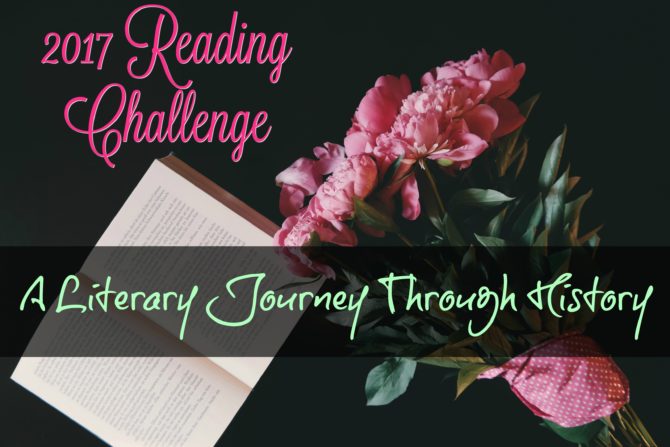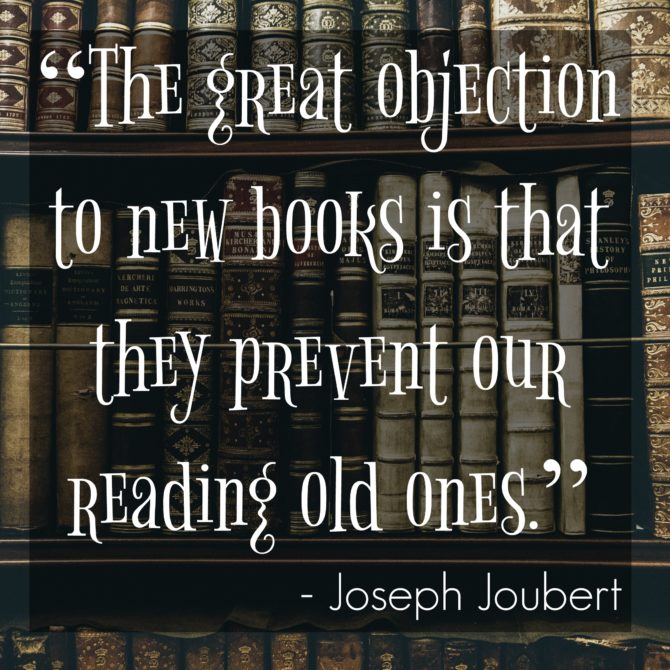It’s no secret that books play a prominent role in my life. Books serve as my favorite form of entertainment, my primary source of information, and a fountain of inspiration for nearly every aspect of my life. Books are a diversion, but they are also so much more than that, and I take my reading life fairly seriously—which leads us to the topic of reading goals.
It’s popular to set a quantitative book goal at the start of the year, but I’ve never had a problem reading enough books, so I don’t feel the need to set a number goal. I’m more concerned about quality than quantity. But without careful attention and concerted deliberation, I fall into the habit of reading books that occupy my time but don’t necessarily challenge my mind or nourish my soul. And that’s where my annual reading challenges come in.
Last year’s challenge infused my reading life with just the right amount of intentionality, prompting me to choose books I might otherwise have left sitting on the shelf. I was happy with my twelve categories, and with the books I read to satisfy each one, and I enjoyed sharing my reviews and selection process here on the blog. I also appreciated the broadness of the categories, which added some flexibility to my book selections and allowed me to satisfy my momentary whims. The challenge was such a great personal success that I decided to do another one in 2017.

This year’s reading challenge will look a little different. Instead of designating categories of books, I’m letting history be my guide. Each month I will read a book from a new decade, beginning with a book written before 1900 and working my way through the 20th century. My twelfth and final book will be one written since 2000.
I’m excited about this year’s challenge because it will prompt me to read a few classics, which are generally outside of my reading comfort zone: I always say I will read these older books, but never quite get around to it. This year’s challenge will change that!
I’ll also be paying attention to the changes that occurred within the literary landscape as the century progressed. Reading just one book to represent each decade won’t give me a complete picture of books being written within each period, but I’m sure I will notice subtle shifts in the style and content of the books I am reading.
I just finished January’s challenge book (written before 1900) and will be sharing a full review next week. I haven’t made my selections for the next eleven books, though, so if you have recommendations for books I should read from a certain decade, please share them with me!

If you’d like to do a reading challenge in 2017, it’s not too late to start! Come up with your own categories, or follow one of the plans on this Master List of 2017 Reading Challenges.
Of course, you can also join me in my reading challenge as I walk through literary history!
[…] year that I’ve participated in a personal Reading Challenge (here’s 2017 and 2016), and it was a highlight of my reading life in 2018. Just for fun, let’s take one […]
[…] My 2017 Reading Challenge was all about acquainting myself with some of those older, established books. I checked twelve classics off my list, reading through one book from each decade of the last century, but that still left me with many classics I still to read (but might need some prompting to actually pick up). Which lead’s to this month’s Challenge theme. […]
[…] did it! We made it through our journey through literary history! At the start of the year I set out to read one book from each decade of the twentieth century, as […]
[…] approaching the end of my reading journey through the twentieth century, and this month I landed in the 1990s. The ’90s are a decade very near and dear to my […]
[…] Perks of Being a Wallflower, by Stephen Chbosky: I’m nearing the end of my 2017 Reading Challenge, and it seemed fitting to pick a book about highschoolers for my Book Written in the 1990s, […]
[…] Perks of Being a Wallflower for the “Book written during the 1990s” category of my 2017 Reading Challenge. I am liking the writing style but having a really hard time with the […]
[…] had a lot of fun with my personal Reading Challenge this year, and the literary snapshots of decades past have given me a better understanding of the […]
[…] at the Whistle Stop Cafe, by Fannie Flagg: I read this as my book written in the 1980s for my 2017 Reading Challenge. I had a hard time getting into the story at first, but ended up really enjoying it. Funny, […]
[…] at the Whistle Stop Cafe, which I’m reading as my book published during the 1980s for my 2017 Reading Challenge. So far it’s not a favorite, but I’m not far enough into the book to make a firm judgment […]
[…] of Solomon, by Toni Morrison: This was my selection for this month’s Reading Challenge category (a book written during the 1970s). It was my first introduction to Toni Morrison and I was […]
[…] Reading Challenge selection for the month (a book written during the 1970s) was Toni Morrison’s Song of […]
[…] hard as it is to believe, we are down to the final third of 2017, which means that my 2017 Reading Challenge journey through literary history is inching closer to the 21st century. This month’s […]
[…] me to reread Lucy Barton—and my impressions this time were very different! . . . . For my Reading Challenge selection this month (a book written during the 1960s), I read The Phantom Tollbooth, a […]
[…] journey through literary history has taken me into the 1950s. Thanks to television and movies, and to having parents who were born […]
[…] at Tiffany’s, by Truman Capote: This was my Reading Challenge selection for a book written during the 1950s. As a fan of the movie, the book wasn’t at all what I […]
[…] at Tiffany’s, by Truman Capote: This was Reading Challenge selection for a book written during the 1950s. As a fan of the movie, the book wasn’t at all what I […]
[…] Reading Challenge category for this month was a book written during the 1950s, and I chose Breakfast at […]
[…] you’ve been following along with my 2017 Reading Challenge, you’ll notice that we’ve approached the year’s halfway point. We (well, I) […]
[…] you know, my personal reading challenge this year is to branch out of my comfort zone (contemporary novels) to read some books that are a […]
[…] Thin Man, by Dashiell Hammett: I read this book for my 2017 Reading Challenge selection as a book written during the 1930s. It wasn’t a favorite, but I’m glad I read […]
[…] a third of the way through my 2017 Reading Challenge, journeying through literature of the twentieth century, and I’ve arrived in the 1920s. […]
[…] Blue Castle, by L.M. Montgomery: I read this as my “book written during the 1920s” for my 2017 Reading Challenge. My previous experiences with L.M. Montgomery were only through the Anne series (which I love) and […]
[…] Blue Castle, by L.M. Montgomery: I read this as my book written during the 1920s for my 2017 Reading Challenge. My previous experiences with L.M. Montogmery were only through the Anne series (which I love) and […]
[…] published in 1911, this was my Reading Challenge pick for a book written between 1910 and 1919. This novella was not at all what i expected, and I had […]
[…] only two months into this year’s reading challenge, but it’s already been a very eye-opening and perspective-shifting experience! Since […]
[…] but Anne of Green Gables came back to my attention when researching titles written in the 1900s for my 2017 Reading Challenge (the book was originally published in 1908). Since I’m trying not to reread books for my […]
[…] time wasters life enhancing activities is exploring random topics on Wikipedia. In preparing for this year’s reading challenge of walking through literary history, I decided to look up “History of Literature” and was […]